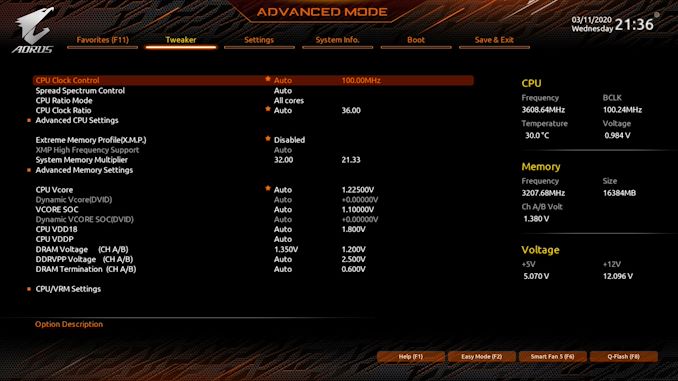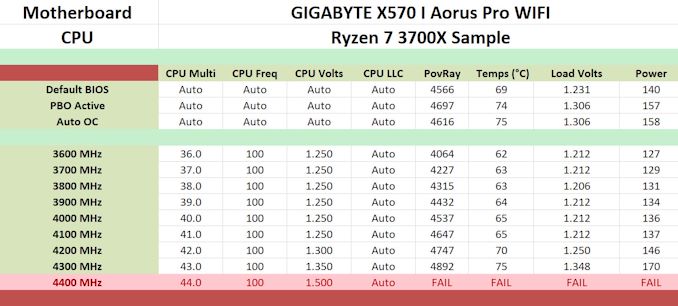On The Wings of an Eagle: GIGABYTE's X570 I Aorus Pro WIFI Motherboard Tested
by Gavin Bonshor on March 19, 2020 10:00 AM ESTOverclocking Ryzen 3000
Experience with the GIGABYTE X570 I Aorus Pro WIFI
It's no secret that Ryzen 3000 runs very warm when pushed beyond default settings and adequate cooling is a must. Our motherboard testing is focused on observing the behaviour and judging capability based on the hardware integrated onto the board including power delivery, circuitry, and other variables including the firmware which acts as the interface between the user and the hardware. One downside to mini ITX motherboards is that all the componentry is stacked tightly together and with this, it can produce more heat in comparison to other form factors with more sparse PCBs. This needs to be factored in when overclocking and it makes airflow even more important, especially in cramped spaces.
GIGABYTE's firmware is very easy to navigate around and all of the relevant overclocking settings can be found within the Tweaker section. Users doing basic overclocking can change key settings including CPU Ratio which will increase or decrease the CPU Core Frequency, and make CPU VCore adjustments for when the processor requires more juice to keep stable. Other important settings to consider include the CPU/VRM settings which allow users to select between different loadline calibrations, which can loosen or tighten the VDroop control for better stability in certain situations.
Memory overclocking can be achieved simply by enabling compatible memory with X.M.P 2.0 profiles or done manually by adjusting the memory frequency, the DRAM voltage, and adjusting latencies which can be found within the advanced memory settings menu. AMD recommends users keeping the FCLK (Infinity Fabric Clock) to within 2:1 of the memory frequency, with DDR4-3600 being the reported sweet spot between performance and frequency. For DDR4-3600, the FCLK should be set to 1800 MHz for best performance.
Overclocking Methodology
Our standard overclocking methodology is as follows. We select the automatic overclock options and test for stability with POV-Ray and OCCT to simulate high-end workloads. These stability tests aim to catch any immediate causes for memory or CPU errors.
For manual overclocks, based on the information gathered from the previous testing, starts off at a nominal voltage and CPU multiplier, and the multiplier is increased until the stability tests are failed. The CPU voltage is increased gradually until the stability tests are passed, and the process repeated until the motherboard reduces the multiplier automatically (due to safety protocol) or the CPU temperature reaches a stupidly high level (105ºC+). Our testbed is not in a case, which should push overclocks higher with fresher (cooler) air.
Overclocking Results
Our experience overclocking the GIGABYTE was a pleasant one and this board exceeded our expectations. For general users, GIGABYTE has gone with a very basic firmware with all the relevant settings in one easy to navigate place. As with all other X570 models tested, we managed to achieve 4.3 GHz on our Ryzen 7 3700X testbed processor with a CPU VCore of 1.350 V. All throughout our overclock testing, VDroop was tight with the LLC settings set to default, and we didn't experience any abnormalities in our testing.
Although GIGABYTE doesn't include any overclocking presets, the EasyTune software comes with a setting called Auto OC which labels itself as an automatic overclocking setting which we assumed is based on a basic lookup table. We didn't achieve any extra performance over enabling PBO, which proved slightly better than default settings at the cost of extra heat and power consumption. In our POV-Ray testing and testing from 3.6 to 4.3 GHz, performance increased gradually as expected.












63 Comments
View All Comments
V1tru - Thursday, March 19, 2020 - link
Got it since launch, usefull info:disable bluetooth/wifi powersaving in Windows device setting, or the wireless card will go crazy after standby
sonny73n - Sunday, March 22, 2020 - link
After all these years and Gigabyte motherboards’ drivers still suck.Smack0Lantern - Sunday, March 22, 2020 - link
When did Gigabyte become a designer and manufacturer of ICs for network/RF controllers? Gigabyte doesn’t write the drivers dumbassInTheMidstOfTheInBeforeCrowd - Monday, March 23, 2020 - link
Yeah, and Gigabyte didn't even choose to put these network/RF controllers with those shonky drivers on their motherboard(s). No, they didn't. A ... uh ... armed and dangerous thooth fairy forced Gigabyte to include specifically those ICs on their motherboards. Gigabyte is not the one to blame here!Nephtys - Monday, April 6, 2020 - link
These drivers are provided by Intel, not Gigabyte.joaolx - Friday, May 8, 2020 - link
Thanks for this! I read this before buying the board and came across this issue. I was going crazy with bluetooth disconnecting every minute after waking from sleep and remembered your comment.shabby - Thursday, March 19, 2020 - link
In before the "it's almost a perfect board but it's missing..." crowd.InTheMidstOfTheInBeforeCrowd - Thursday, March 19, 2020 - link
Well, it's not actually missing something, but rather has some superfluous stuff that would befit a board of such compact form factor much better when left out. I am talking about the squirrel cage fan here, which of course is necessary because X570. But then again, a small board such as this hardly benefits from all the I/O options the X570 offers. A chipset nod needing active cooling would be much nicer.Unfortunately, such a chipset doesn't exist presently and one either has to begrudingly accept either squirrel-cage-fan-X570 or B450-pardon-i-meant-B550A, or just refuse to buy this stuff
(Yeah, obviously the latter is me. I am at a point where i want to do a major system upgrade towards Ryzen, but AMDs underwhelming chipset strategy kind of erodes the confidence their latest CPU offerings instill. Not saying that Intel is presenting themselves in a more favourable light. So i am still holding off to see how things develop with regards to both players...)
Slash3 - Thursday, March 19, 2020 - link
I replaced the fan on my X570 Taichi with an HB-802 passive heatsink. Works great.Makaveli - Friday, March 20, 2020 - link
i've never heard the chipset fan once on my x570 build.I think people may a bigger deal over it than necessary.